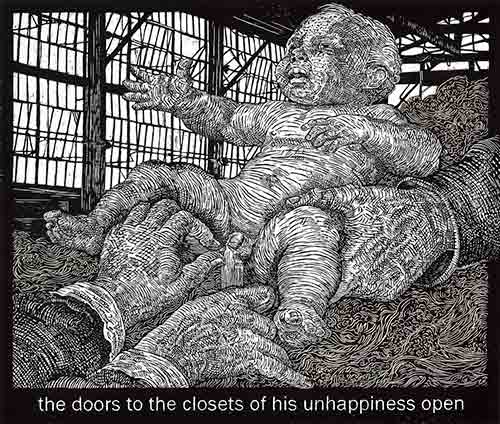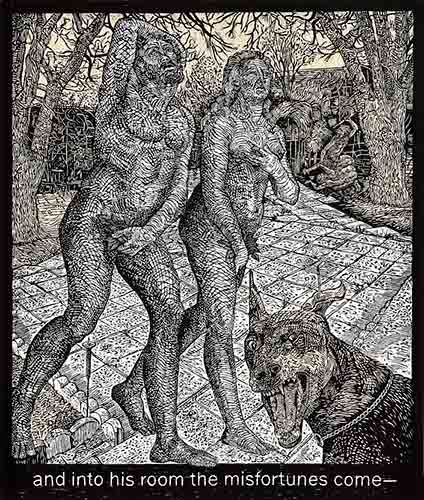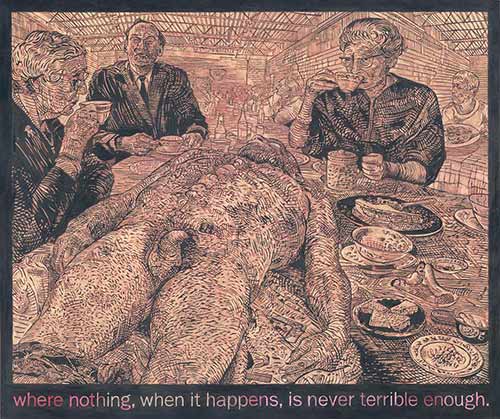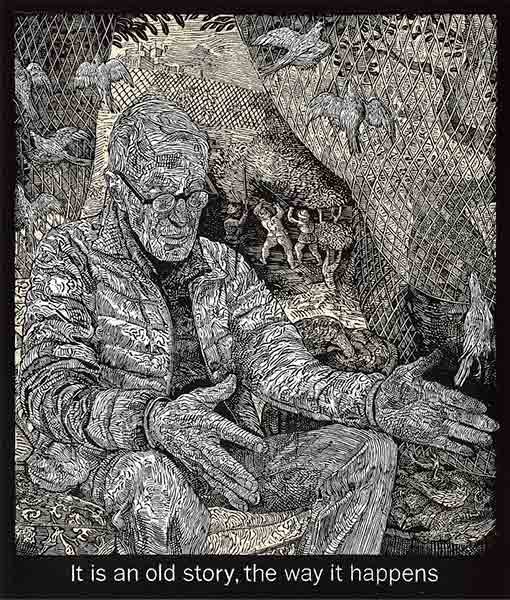Out of a dark world in which death seems commonplace, a spark of light flashes through the intensely powerful and personal artworks by Alice Leora Briggs. Fine Art Today recently caught up with the artist, who graciously revealed parts of her artistic visions and personal journeys.
Hindsight is 20/20, and thank goodness Alice Leora Briggs failed at just about every creative expression she tried, be that music, dance, or theater. Why? Because those failures led her to the visual arts, more specifically printmaking and drawing, two mediums in which the artist has become nearly unrivaled in skill and personal expression.

“Apparently, I like to cut things” she asserts. “Whether I am making a sgraffito drawing or a woodcut, I cut white marks into black fields. Each slash throws a spark into dark territory; each mark is a scar. I have a manic duty to botch up surfaces. Each of my images is an accumulation of thousands of marks that chart how my eyes jerk and scan through spaces and whatever these spaces contain. For me, poetry comes from mortal substance — the physical experience of my body moving through the world and an acute awareness that my presence in the world is temporary.”

Indeed, the triumph over personal tragedy often reveals the strength of one’s resolve, and Briggs’s art has “evolved as an effort to comprehend the black hole that replaced a family member I had not yet learned to distinguish from myself,” she said.
Buzzing about her studio in strife-torn Juárez, Mexico, Briggs is no stranger to death and chaos, and it is an environment that has proven to be a point of clarity for the artist. She writes, “I am drawn to places where death is familiar. I do not romanticize such circumstances; they simple clarify what matters to me.”
Through exquisite detail and powerful, expressive marks, prints such as “where nothing, when it happens, is never terrible enough” remind us all of that which we might care not to see, or admit. Recalling the controversial painting “Dead Christ” by the Renaissance artist Andrea Mantegna, a deceased body, highly foreshortened, lies on a dinner table. All around, individuals drink their beverages and sip their tea without acknowledging the cadaver. Beneath the composition are the words, “where nothing, when it happens, is never terrible enough.” The work is unsettling, but masterfully composed and executed.

Of her artistic goals, Briggs writes, “I am trying to find something beautiful, even though it is clear to all of us that we often have to look through a dense thicket of atrocities to see it. I have grown to love even this dense undergrowth that blackens our view.”

The future is bright for Briggs, who recently began an ambitious five-year project, details of which are tantalizingly vague. The artist did, however, offer this: “Five large-scale drawing/constructions (each 80+ square feet).” More broadly speaking, Briggs will “continue to move forward with visual narratives in printmaking, including a long-anticipated return to engraving and drypoint.”
To learn more, visit Alice Leora Briggs.
This article was featured in Fine Art Today, a weekly e-newsletter from Fine Art Connoisseur magazine. To start receiving Fine Art Today for free, click here.








